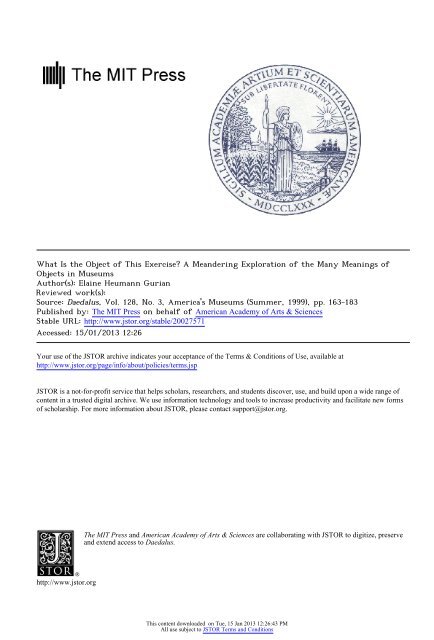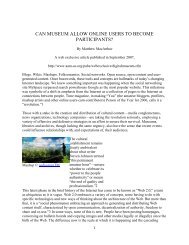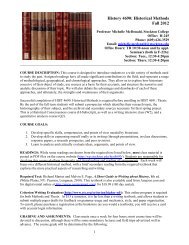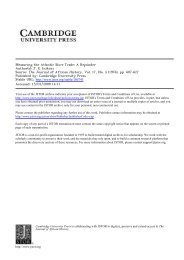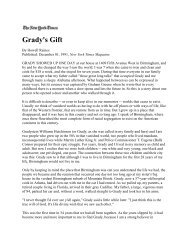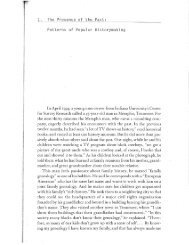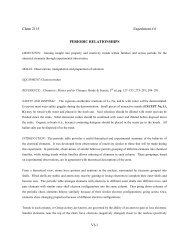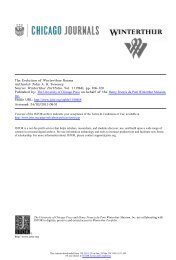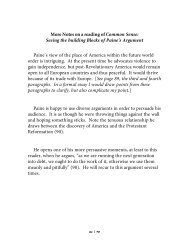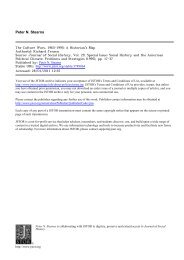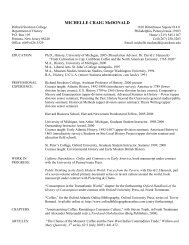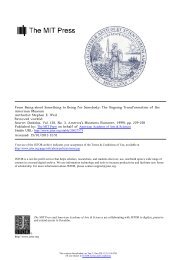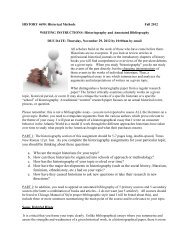What Is the Object of This Exercise? A Meandering Exploration of ...
What Is the Object of This Exercise? A Meandering Exploration of ...
What Is the Object of This Exercise? A Meandering Exploration of ...
You also want an ePaper? Increase the reach of your titles
YUMPU automatically turns print PDFs into web optimized ePapers that Google loves.
<strong>What</strong> <strong>Is</strong> <strong>the</strong> <strong>Object</strong> <strong>of</strong> <strong>This</strong> <strong>Exercise</strong>? A <strong>Meandering</strong> <strong>Exploration</strong> <strong>of</strong> <strong>the</strong> Many Meanings <strong>of</strong><br />
<strong>Object</strong>s in Museums<br />
Author(s): Elaine Heumann Gurian<br />
Reviewed work(s):<br />
Source: Daedalus, Vol. 128, No. 3, America's Museums (Summer, 1999), pp. 163-183<br />
Published by: The MIT Press on behalf <strong>of</strong> American Academy <strong>of</strong> Arts & Sciences<br />
Stable URL: http://www.jstor.org/stable/20027571 .<br />
Accessed: 15/01/2013 12:26<br />
Your use <strong>of</strong> <strong>the</strong> JSTOR archive indicates your acceptance <strong>of</strong> <strong>the</strong> Terms & Conditions <strong>of</strong> Use, available at .<br />
http://www.jstor.org/page/info/about/policies/terms.jsp<br />
.<br />
JSTOR is a not-for-pr<strong>of</strong>it service that helps scholars, researchers, and students discover, use, and build upon a wide range <strong>of</strong><br />
content in a trusted digital archive. We use information technology and tools to increase productivity and facilitate new forms<br />
<strong>of</strong> scholarship. For more information about JSTOR, please contact support@jstor.org.<br />
.<br />
http://www.jstor.org<br />
The MIT Press and American Academy <strong>of</strong> Arts & Sciences are collaborating with JSTOR to digitize, preserve<br />
and extend access to Daedalus.<br />
<strong>This</strong> content downloaded on Tue, 15 Jan 2013 12:26:43 PM<br />
All use subject to JSTOR Terms and Conditions
Elaine Heumann Gurian<br />
<strong>What</strong> is <strong>the</strong> <strong>Object</strong> <strong>of</strong> this <strong>Exercise</strong>?<br />
A <strong>Meandering</strong> <strong>Exploration</strong> <strong>of</strong> <strong>the</strong><br />
Many Meanings <strong>of</strong> <strong>Object</strong>s in<br />
Museums<br />
CC^^T^Thy<br />
\ \ /<br />
W<br />
did <strong>the</strong> serbs and Croats shell each o<strong>the</strong>r's historic<br />
sites when <strong>the</strong>y had so little ammunition and <strong>the</strong>se<br />
were not<br />
military targets?" I routinely ask my mu<br />
seum-studies graduate students this question when I lecture.<br />
"To break <strong>the</strong>ir spirit," is always <strong>the</strong> instantaneous answer.<br />
Museums, historic sites, and o<strong>the</strong>r institutions <strong>of</strong> memory, I<br />
would contend,<br />
are <strong>the</strong> tangible evidence <strong>of</strong> <strong>the</strong> spirit <strong>of</strong> a<br />
civilized society. And while <strong>the</strong> proponents <strong>of</strong> museums have<br />
long asserted that museums add to <strong>the</strong> quality <strong>of</strong> life, <strong>the</strong>y have<br />
not understood (as <strong>the</strong> graduate students did when confronted<br />
by <strong>the</strong> example <strong>of</strong> war) how pr<strong>of</strong>ound and even central that<br />
"quality"<br />
was.<br />
Similar examples reveal <strong>the</strong> relationship between museums<br />
and "spirit"<br />
in<br />
sharp detail. Why did <strong>the</strong> Russians proclaim,<br />
one<br />
day after <strong>the</strong> Russian r?volution had succeeded, that all<br />
historic monuments were to be protected<br />
even<br />
though <strong>the</strong>y<br />
most <strong>of</strong>ten represented <strong>the</strong> hated czar and <strong>the</strong> church? Why did<br />
Hitler and Stalin establish lists <strong>of</strong> acceptable and unacceptable<br />
art and <strong>the</strong>n install shows in museums to proclaim <strong>the</strong>m while<br />
sending <strong>the</strong> formerly acclaimed, now<br />
forbidden, art to<br />
storage?<br />
Why did <strong>the</strong> Nazis stockpile Jewish material and force interned<br />
Elaine Heumann Gurian is acting director <strong>of</strong> <strong>the</strong> Cranbrook Institute <strong>of</strong><br />
Bloomfield Hills, Michigan.<br />
163<br />
<strong>This</strong> content downloaded on Tue, 15 Jan 2013 12:26:43 PM<br />
All use subject to JSTOR Terms and Conditions<br />
Science in
164 Elaine Heumann Gurian<br />
curators to<br />
catalog and accession it, intending<br />
to create a<br />
museum to <strong>the</strong> eradicated Jews? Why, when I was in <strong>the</strong> rural<br />
mountains <strong>of</strong> <strong>the</strong> Philippines,<br />
was I taken to hidden closets that<br />
served as museums, curated by tribal members, holding <strong>the</strong><br />
material <strong>of</strong> <strong>the</strong> tribe's immediate past, secreted from <strong>the</strong> dealers<br />
who were<br />
<strong>of</strong>fering great<br />
sums for <strong>the</strong> same material?<br />
In<br />
adversity<br />
it is understood, by antagonists and protagonists<br />
alike, that <strong>the</strong> evidence <strong>of</strong> history has something central to do<br />
with <strong>the</strong> spirit, will, pride, identity, and civility <strong>of</strong> people, and<br />
that destroying such material may lead to<br />
forgetting, broken<br />
spirits, and docility. <strong>This</strong> same<br />
understanding<br />
is what motivates<br />
cultural and ethnic communities to create <strong>the</strong>ir own museums in<br />
order to tell <strong>the</strong>ir stories, in <strong>the</strong>ir own way, to <strong>the</strong>mselves and<br />
to o<strong>the</strong>rs.<br />
Yet nei<strong>the</strong>r <strong>the</strong> museum<br />
pr<strong>of</strong>ession<br />
nor its sibling workers in<br />
<strong>the</strong> o<strong>the</strong>r storehouses <strong>of</strong> collective memory (archives, libraries,<br />
concert halls, and so<br />
forth), makes (nor, I would contend,<br />
understands) <strong>the</strong> case<br />
clearly about its institution's connected<br />
ness to <strong>the</strong> soul <strong>of</strong> civic life. In cities under duress you can hear<br />
<strong>the</strong> case being made better by mayors and governors. Dennis<br />
Archer, <strong>the</strong> mayor <strong>of</strong> Detroit, said recently while being inter<br />
viewed on <strong>the</strong> radio, "Detroit, in order to be a great city, needs<br />
to protect its great art museum, <strong>the</strong> Detroit Institute <strong>of</strong> Art." It<br />
was Archer and his predecessor, Coleman Young, who cham<br />
pioned and underwrote <strong>the</strong> latest incarnation <strong>of</strong> Detroit's Mu<br />
seum <strong>of</strong> African American History. And it was Teddy Kolik, <strong>the</strong><br />
fabled former mayor <strong>of</strong> Jerusalem, who was <strong>the</strong> chief propo<br />
nent <strong>of</strong> <strong>the</strong> creation <strong>of</strong> <strong>the</strong> <strong>Is</strong>rael Museum (and who <strong>of</strong> his two <strong>of</strong>fices within <strong>the</strong> building). Mayors<br />
placed<br />
one<br />
know why<br />
museums are<br />
important. Citizens, implicitly, do too. A recent<br />
survey in Detroit asked people<br />
to rate <strong>the</strong> importance <strong>of</strong> insti<br />
tutions to <strong>the</strong>ir city and <strong>the</strong>n tell which <strong>the</strong>y had visited. The<br />
Museum <strong>of</strong> African American History<br />
was listed very high<br />
on<br />
<strong>the</strong> important list and much lower on <strong>the</strong> "I have visited" list.<br />
People do not have to use <strong>the</strong> museum in order to assert its<br />
importance<br />
its support.<br />
or feel that <strong>the</strong>ir tax dollars are<br />
being well spent in<br />
The people who work in museums have collectively struggled<br />
over <strong>the</strong> proper definition and role <strong>of</strong> <strong>the</strong>ir institutions. Their<br />
<strong>This</strong> content downloaded on Tue, 15 Jan 2013 12:26:43 PM<br />
All use subject to JSTOR Terms and Conditions
The Many Meanings <strong>of</strong> <strong>Object</strong>s in Museums 165<br />
struggle has been, in part, to differentiate museums from o<strong>the</strong>r<br />
near relatives?<strong>the</strong> o<strong>the</strong>r storehouses <strong>of</strong> collective memory.<br />
The resulting definitions have <strong>of</strong>ten centered on<br />
things?on<br />
objects<br />
missed<br />
and <strong>the</strong>ir permissible<br />
<strong>the</strong> essential meaning<br />
uses. I believe <strong>the</strong> debate has<br />
(<strong>the</strong> soul, if you will) <strong>of</strong> <strong>the</strong> insti<br />
tution that is <strong>the</strong> museum.<br />
OBJECTS<br />
ARE NOT THE HEART OF THE MUSEUM<br />
The following discussion will attempt to capture that soul by<br />
throwing light on <strong>the</strong> shifting role <strong>of</strong> museum<br />
objects<br />
over time.<br />
It will show how elusive objects are, even as<br />
<strong>the</strong>y remain <strong>the</strong><br />
central element embedded within all definitions <strong>of</strong> museums.<br />
<strong>This</strong> essay will also postulate that <strong>the</strong> definition <strong>of</strong> a "museum<br />
object" and <strong>the</strong> associated practices <strong>of</strong> acquisition, preserva<br />
tion, care, display, study, and interpretation have always been<br />
fluid and have become more so<br />
recently. <strong>Object</strong>s did not pro<br />
vide <strong>the</strong> definitional bedrock in <strong>the</strong> past, although<br />
museum<br />
staffs thought <strong>the</strong>y did. I will show that museums may not need<br />
<strong>the</strong>m any longer<br />
to<br />
justify <strong>the</strong>ir work.<br />
But if <strong>the</strong> essence <strong>of</strong> a museum is not to be found in its objects,<br />
<strong>the</strong>n where? I propose that <strong>the</strong> answer is in<br />
being<br />
a<br />
place that<br />
stores memories and presents and organizes meaning in some<br />
sensory form. It is both <strong>the</strong> physicality <strong>of</strong> a place and <strong>the</strong><br />
memories and stories told <strong>the</strong>rein that are<br />
important. Fur<strong>the</strong>r,<br />
I propose that <strong>the</strong>se two essential ingredients?place and re<br />
membrances?are not exclusive to museums. And, finally, I<br />
contend that <strong>the</strong> blurring <strong>of</strong> <strong>the</strong> distinctions between <strong>the</strong>se<br />
institutions <strong>of</strong> memory and o<strong>the</strong>r seemingly separate institu<br />
tions (like shopping malls and attractions) is a positive, ra<strong>the</strong>r<br />
than negative, development.<br />
Not meaning<br />
to<br />
denigrate <strong>the</strong> immense importance <strong>of</strong> mu<br />
seum<br />
objects and <strong>the</strong>ir care, I am<br />
postulating that <strong>the</strong>y, like<br />
props in a brilliant play,<br />
are necessary but alone are not suffi<br />
cient. <strong>This</strong> essay points<br />
out<br />
something that we have always<br />
known intuitively: that <strong>the</strong> larger issues revolve around <strong>the</strong><br />
stories museums tell and <strong>the</strong> way <strong>the</strong>y tell <strong>the</strong>m. When parsed<br />
carefully, <strong>the</strong> objects,<br />
in <strong>the</strong>ir tangibility, provide<br />
a<br />
variety <strong>of</strong><br />
stakeholders with an<br />
opportunity<br />
to debate <strong>the</strong> meaning and<br />
<strong>This</strong> content downloaded on Tue, 15 Jan 2013 12:26:43 PM<br />
All use subject to JSTOR Terms and Conditions
166 Elaine Heumann Gurian<br />
control <strong>of</strong> <strong>the</strong>ir memories. It is <strong>the</strong> ownership <strong>of</strong> <strong>the</strong> story,<br />
ra<strong>the</strong>r than <strong>the</strong> object itself, that <strong>the</strong> dispute has been all about.<br />
<strong>This</strong> essay suggests what museums are not (or not<br />
exactly)<br />
and, <strong>the</strong>refore, continues <strong>the</strong> dialogue about what museums are<br />
and what makes <strong>the</strong>m important,<br />
so<br />
important that people in<br />
extremis fight<br />
over <strong>the</strong>m.<br />
WHAT IS AN OBJECT?<br />
"Ah, but we have <strong>the</strong> real thing," museum<br />
pr<strong>of</strong>essionals used to<br />
say when touting <strong>the</strong> uniqueness <strong>of</strong> <strong>the</strong>ir occupation. When I<br />
began<br />
in museum<br />
work, in <strong>the</strong> late 1960s and early 1970s, <strong>the</strong><br />
definition <strong>of</strong> museums<br />
always contained reference to <strong>the</strong> object<br />
as <strong>the</strong> pivot around which we<br />
justified<br />
our o<strong>the</strong>r activities.1<br />
Although <strong>the</strong>re were<br />
always o<strong>the</strong>r parts <strong>of</strong> <strong>the</strong> definition, our<br />
security none<strong>the</strong>less lay in owning objects. With it came our<br />
privileged responsibility for <strong>the</strong> attendant acquisition, its pres<br />
ervation, safety, display, study, and interpretation. We were<br />
like priests and <strong>the</strong> museums our<br />
reliquaries.<br />
The definition <strong>of</strong> objects<br />
was easy. They<br />
were <strong>the</strong> real stuff.<br />
Words were used like "unique," "au<strong>the</strong>ntic," "original," "genu<br />
ine," "actual." The things that were collected had significance<br />
and were within <strong>the</strong> natural, cultural,<br />
or aes<strong>the</strong>tic history <strong>of</strong> <strong>the</strong><br />
known world.<br />
Of course, real had more than one meaning. It <strong>of</strong>ten meant<br />
"one <strong>of</strong> a kind," but it also meant "an<br />
example <strong>of</strong>." Thus,<br />
artworks were one-<strong>of</strong>-a-kind, but eighteenth-century farm imple<br />
ments may have been examples. Things made by hand were<br />
unique, but manufactured items became examples.<br />
In <strong>the</strong> natu<br />
ral history world, almost all specimens<br />
were<br />
examples but had<br />
specificity<br />
as to location found. Yet some could also be unique?<br />
<strong>the</strong> last passenger pigeon or <strong>the</strong> last dodo bird. <strong>Object</strong>s from<br />
both categories, unique and example,<br />
were accessioned into <strong>the</strong><br />
collections. Museums owned <strong>the</strong> objects and took on <strong>the</strong> re<br />
sponsibility <strong>of</strong> preserving, studying, and displaying <strong>the</strong>m.<br />
Yet even within <strong>the</strong>se seemingly easy categories <strong>the</strong>re were<br />
variations. In<br />
asserting uniqueness (as in made-by-hand), spe<br />
cific authorship<br />
was associated with some<br />
objects, such as<br />
paintings, but not with o<strong>the</strong>rs, most<br />
especially utilitarian works<br />
<strong>This</strong> content downloaded on Tue, 15 Jan 2013 12:26:43 PM<br />
All use subject to JSTOR Terms and Conditions
The Many Meanings <strong>of</strong> <strong>Object</strong>s in Museums 167<br />
whose makers were <strong>of</strong>ten unknown. Some unique works were<br />
thought <strong>of</strong> as "art" and some as<br />
"craft"; with some notable<br />
exceptions,<br />
art was individualized as to maker but craft was<br />
not. <strong>This</strong> practice, which is now<br />
changing, made it possible<br />
to<br />
do research and mount shows <strong>of</strong> <strong>the</strong> work <strong>of</strong> particular artists<br />
in some, but not all, cultures.<br />
WHAT ARE COLLECTIONS?<br />
In <strong>the</strong> early 1970s <strong>the</strong> American Association <strong>of</strong> Museums (AAM)<br />
established an Accreditation Commission. As its members de<br />
liberated, <strong>the</strong>y discussed whe<strong>the</strong>r groups <strong>of</strong> living things could<br />
be called collections and whe<strong>the</strong>r institutions that so "col<br />
lected" should be classified as museums.<br />
Heret<strong>of</strong>ore, "muse<br />
ums" were<br />
conserving things that had never<br />
been,<br />
or now were<br />
no longer, alive. The field debated if <strong>the</strong> living things in botani<br />
cal gardens, fish in aquaria,<br />
or animals in zoos were "collec<br />
tions"; if so, were those institutions, de facto, museums? It was<br />
decided that, yes, at least for funding and accreditation pur<br />
poses, <strong>the</strong>y were museums, and <strong>the</strong> living things <strong>the</strong>y cared for<br />
were likewise to be regarded<br />
as<br />
collections, and hence objects.2<br />
Yet <strong>the</strong>re were o<strong>the</strong>r institutional repositories that cared for,<br />
protected, preserved, and taught about "objects" but were not<br />
called museums nor necessarily treated by museums as siblings.<br />
Archives and libraries, especially rare-book collections, were<br />
considered related but not<br />
siblings<br />
even<br />
though<br />
some museum<br />
collections contain <strong>the</strong> identical materials. There were also<br />
commercial galleries and private and corporate collections that<br />
were considered by museum<br />
pr<strong>of</strong>essionals<br />
to be different and<br />
outside <strong>the</strong> field, separated supposedly by an underlying pur<br />
pose. A<br />
legal distinction <strong>of</strong> "not-for-pr<strong>of</strong>it"<br />
was considered an<br />
essential part <strong>of</strong> <strong>the</strong> definition <strong>of</strong> a museum. It was clear that<br />
while objects formed <strong>the</strong> necessary foundation upon which <strong>the</strong><br />
definition<br />
<strong>the</strong>mselves.<br />
<strong>of</strong> a museum<br />
might rest, <strong>the</strong>y<br />
were not<br />
sufficient in<br />
CAN NONCOLLECTING INSTITUTIONS BE MUSEUMS?<br />
The Accreditation Commission <strong>of</strong> <strong>the</strong> AAM next<br />
sought<br />
determine if places that resembled collections-based museums<br />
<strong>This</strong> content downloaded on Tue, 15 Jan 2013 12:26:43 PM<br />
All use subject to JSTOR Terms and Conditions<br />
to
168 Elaine Heumann Gurian<br />
but did not hold collections (i.e., places like not-for-pr<strong>of</strong>it gal<br />
leries and cultural centers) were, for purposes <strong>of</strong> accreditation,<br />
also museums. In 1978, <strong>the</strong>y decided that, in some instances,<br />
galleries could be considered museums<br />
because, like museums,<br />
<strong>the</strong>y cared for, displayed, and preserved objects<br />
even<br />
though<br />
<strong>the</strong>y did not own <strong>the</strong>m. Ownership, <strong>the</strong>refore, in some in<br />
stances, no<br />
longer defined museums.<br />
There was also <strong>the</strong> conundrum brought<br />
to <strong>the</strong> pr<strong>of</strong>ession by<br />
science centers and children's museums, mostly <strong>of</strong> <strong>the</strong> mid<br />
twentieth century. Earlier in <strong>the</strong> century, <strong>the</strong>se places had<br />
collected and displayed objects, but by mid-century children's<br />
museums and science centers were<br />
proliferating and creating<br />
new<br />
public experiences, using exhibition material that was built<br />
specifically for <strong>the</strong> purpose and omitting collections objects<br />
altoge<strong>the</strong>r.<br />
How were <strong>the</strong>se "purpose-built" objects<br />
to be con<br />
sidered? They<br />
were<br />
three-dimensional, <strong>of</strong>ten unique, many times<br />
extremely well made, but <strong>the</strong>y had no cognates in <strong>the</strong> outside<br />
world. Much <strong>of</strong> this exhibit material was built to demonstrate<br />
<strong>the</strong> activity and function <strong>of</strong> <strong>the</strong> "real" (and now inactive)<br />
machinery sitting beside it.<br />
The Adler Planetarium, applying<br />
to <strong>the</strong> AAM for accredita<br />
tion, also caused <strong>the</strong> AAM to reconsider <strong>the</strong> definition <strong>of</strong> a<br />
museum. The planetarium's object was a machine that pro<br />
jected<br />
stars onto a<br />
ceiling. If institutions relied on such "ob<br />
jects," were <strong>the</strong>se places museums? Had <strong>the</strong> pr<strong>of</strong>ession inad<br />
vertently crafted a definition <strong>of</strong> objects that was restricted to<br />
those things that were created elsewhere and were <strong>the</strong>n trans<br />
ported<br />
to museums? That was not <strong>the</strong> case in art museums that<br />
commissioned site-specific work. Certainly <strong>the</strong> murals <strong>of</strong> <strong>the</strong><br />
depression period applied directly<br />
to museum walls were<br />
accessionable works <strong>of</strong> art?an easy call! Portability, <strong>the</strong>n, did<br />
not define objects.<br />
In 1978, <strong>the</strong> Accreditation Commission <strong>of</strong> <strong>the</strong> AAM, citing<br />
<strong>the</strong>se three different types <strong>of</strong> noncolkctions-based institutions<br />
(art centers, science and technology centers, and plan?tariums),<br />
wrote<br />
specific language for each type <strong>of</strong> museum and, by amending<br />
its definition <strong>of</strong> collections for each group, declared <strong>the</strong>se types<br />
<strong>of</strong> organizations<br />
to be . . . museums! They elaborated: "The<br />
existence <strong>of</strong> collections and supporting exhibitions is considered<br />
<strong>This</strong> content downloaded on Tue, 15 Jan 2013 12:26:43 PM<br />
All use subject to JSTOR Terms and Conditions
The Many Meanings <strong>of</strong> <strong>Object</strong>s in Museums 169<br />
desirable, but <strong>the</strong>ir absence is not<br />
disabling.<br />
. . ."3 In response,<br />
many museums set about creating<br />
more than one set <strong>of</strong> rules?<br />
one for accessioned objects, and ano<strong>the</strong>r for exhibitions mate<br />
rial?and began<br />
to understand that <strong>the</strong> handkable material<br />
<strong>the</strong>y used in <strong>the</strong>ir classes (<strong>the</strong>ir teaching collections) should be<br />
governed by<br />
a different set <strong>of</strong> criteria as well.<br />
Never<strong>the</strong>less, <strong>the</strong>re were <strong>of</strong>ten no easy distinctions between<br />
<strong>the</strong> handkablity <strong>of</strong> teaching collections' objects and those oth<br />
ers deserving preservation. The Boston Children's Museum<br />
loan boxes, for example, created in <strong>the</strong> 1960s, contained easy<br />
to-obtain material about Nor<strong>the</strong>ast Native Americans. But by<br />
<strong>the</strong> 1980s, <strong>the</strong> remaining material was retired from <strong>the</strong> loan<br />
boxes and accessioned into <strong>the</strong> collections because it was no<br />
longer obtainable and had become rare and valuable.<br />
Even purpose-built "environments" have, in cases such as <strong>the</strong><br />
synagogue models in <strong>the</strong> Museum <strong>of</strong> <strong>the</strong> Diaspora<br />
in Tel Aviv,<br />
become so<br />
intriguing<br />
or are <strong>of</strong> such craftsmanship that <strong>the</strong>y,<br />
decades later, become collections' objects <strong>the</strong>mselves. So, too,<br />
have <strong>the</strong> exhibitions created by distinguished artists, such as<br />
parts <strong>of</strong> Charles and Ray Eames's exhibit Ma<strong>the</strong>matical A<br />
World <strong>of</strong> Numbers and Beyond.<br />
Dioramas were <strong>of</strong>ten built for a museum exhibition hall in<br />
order to put objects (mostly animals) in context. These display<br />
techniques, which were considered a craft at <strong>the</strong> time <strong>the</strong>y were<br />
created, were<br />
occasionally <strong>of</strong> such beauty, and displayed artis<br />
tic conventions <strong>of</strong> realism (and seeming realism) so<br />
special, that<br />
today <strong>the</strong> original dioramas <strong>the</strong>mselves have become "objects,"<br />
and many are<br />
subject<br />
to<br />
preservation, accession, and special<br />
display. The definition <strong>of</strong> objects suitable for collections has,<br />
<strong>the</strong>refore, expanded<br />
to include, in<br />
special cases, material built<br />
for <strong>the</strong> museum itself.<br />
WHAT IS REAL? IS THE EXPERIENCE THE OBJECT?<br />
In <strong>the</strong> nineteenth century, some museums had and displayed<br />
sculptural plaster castings and studies. The Louvre and o<strong>the</strong>r<br />
museums had rooms devoted to copies <strong>of</strong> famous sculptures<br />
that <strong>the</strong> museum did not own. The originals ei<strong>the</strong>r remained in<br />
situ or were held by o<strong>the</strong>rs. People<br />
<strong>This</strong> content downloaded on Tue, 15 Jan 2013 12:26:43 PM<br />
All use subject to JSTOR Terms and Conditions<br />
came to see, study, and paint
170 Elaine Heumann Gurian<br />
<strong>the</strong>se reproductions. They were treated with <strong>the</strong> respect<br />
ac<br />
corded <strong>the</strong> real thing. For a<br />
long time, museums and <strong>the</strong>ir<br />
publics have felt that though <strong>the</strong>re were differences between<br />
<strong>the</strong> "original" and reproductions, both had a<br />
place within <strong>the</strong>ir<br />
walls.<br />
Similarly, reconstructed skeletons <strong>of</strong> dinosaurs have long<br />
appeared<br />
in museums.<br />
They usually<br />
are a combination <strong>of</strong> <strong>the</strong><br />
bones <strong>of</strong> <strong>the</strong> species owned by <strong>the</strong> museums<br />
plus <strong>the</strong> casting <strong>of</strong><br />
<strong>the</strong> missing bones from <strong>the</strong> same<br />
species owned by<br />
someone<br />
else. Sometimes museums<br />
point<br />
out which part is real and<br />
which is cast, but <strong>of</strong>ten <strong>the</strong>y do not. "Real," <strong>the</strong>refore, takes on<br />
new meaning. Curators recognize that <strong>the</strong> experience <strong>of</strong> seeing<br />
<strong>the</strong> whole skeleton is more<br />
"real," and certainly more informa<br />
tive, than seeing only <strong>the</strong> au<strong>the</strong>ntic, unattached bones that do<br />
not add up to a<br />
complete<br />
or understandable image.<br />
Likewise, multiples<br />
or limited editions were<br />
always consid<br />
ered "real" as<br />
long<br />
as <strong>the</strong> intention <strong>of</strong> <strong>the</strong> artist was<br />
respected.<br />
Thus, <strong>the</strong> fact that Rodin and many o<strong>the</strong>rs authorized <strong>the</strong><br />
multiple production <strong>of</strong> some<br />
pieces did not seem to make each<br />
one any less real or less unique. The creation <strong>of</strong> additional,<br />
though still limited, copies, using <strong>the</strong> same<br />
etching plates, but<br />
after <strong>the</strong> death <strong>of</strong> <strong>the</strong> artist, caused more<br />
problems.<br />
But <strong>of</strong>ten,<br />
while acknowledging <strong>the</strong> facts <strong>of</strong> <strong>the</strong> edition, such works also<br />
hung in museums and, if <strong>the</strong> quality<br />
was<br />
into <strong>the</strong>ir collections.<br />
IS THE IMAGE THE OBJECT?<br />
good,<br />
were accessioned<br />
The twentieth century's invention <strong>of</strong> new<br />
technologies has made<br />
multiples <strong>the</strong> norm and made determining what is real and what<br />
that means much more difficult. While original prints <strong>of</strong> movies,<br />
for example, exist, it is <strong>the</strong> moving image that <strong>the</strong> public thinks<br />
<strong>of</strong> as <strong>the</strong> object ra<strong>the</strong>r than <strong>the</strong> master<br />
print <strong>of</strong> film. Questions<br />
<strong>of</strong> au<strong>the</strong>nticity revolve around subsequent manipulation <strong>of</strong> <strong>the</strong><br />
image (e.g., colorization, cutting,<br />
or<br />
cropping) ra<strong>the</strong>r than <strong>the</strong><br />
contents <strong>of</strong> any particular<br />
canister.<br />
Printed editions with identical multiples<br />
are considered origi<br />
nals, and become more valuable, if signed; unsigned editions<br />
are considered less "real" and certainly less valuable. In such<br />
<strong>This</strong> content downloaded on Tue, 15 Jan 2013 12:26:43 PM<br />
All use subject to JSTOR Terms and Conditions
The Many Meanings <strong>of</strong> <strong>Object</strong>s in Museums 171<br />
cases one could say that <strong>the</strong> signature, ra<strong>the</strong>r than <strong>the</strong> image,<br />
becomes <strong>the</strong> object. Photographs printed by <strong>the</strong> photographer<br />
may be considered more real than those using <strong>the</strong> same nega<br />
tive but printed by<br />
someone else. With <strong>the</strong> invention <strong>of</strong> digital<br />
technology, many identical images<br />
can be reproduced<br />
at will<br />
without recourse to any negative at all. So <strong>the</strong> notion <strong>of</strong> au<strong>the</strong>n<br />
ticity (meaning singularity<br />
or<br />
uniqueness) becomes problematic<br />
as<br />
images indistinguishable from those in museums are<br />
easily<br />
available outside <strong>the</strong> museum. It is <strong>the</strong> artist's sensibility that<br />
produced <strong>the</strong> image. It is <strong>the</strong> image itself, <strong>the</strong>refore, that is <strong>the</strong><br />
object.<br />
IS THE STORY THE OBJECT?<br />
Of <strong>the</strong> utilitarian objects <strong>of</strong> <strong>the</strong> twentieth century, most are<br />
manufactured in<br />
huge quantities and <strong>the</strong>refore could be termed<br />
"examples." Which <strong>of</strong> <strong>the</strong>se objects<br />
to collect <strong>of</strong>ten <strong>the</strong>n de<br />
pends<br />
not upon <strong>the</strong> object itself but on an associated story that<br />
may render one <strong>of</strong> <strong>the</strong>m unique<br />
or<br />
important.<br />
The objects present in <strong>the</strong> death camps <strong>of</strong> <strong>the</strong> Holocaust<br />
were, in <strong>the</strong> main, created for use elsewhere. There is<br />
nothing<br />
unique in <strong>the</strong> physicality <strong>of</strong> a bowl that comes from Auschwitz<br />
Birkenau. These bowls could have been purchased<br />
in<br />
shops that<br />
sold cheap tableware all over Germany at <strong>the</strong> time. However,<br />
when <strong>the</strong> visitor reads <strong>the</strong> label that says <strong>the</strong> bowl comes from<br />
Auschwitz, <strong>the</strong> viewer, knowing something about <strong>the</strong> Holo<br />
caust, transfers meaning<br />
to <strong>the</strong> object. Since <strong>the</strong>re is nothing<br />
aside from <strong>the</strong> label that makes <strong>the</strong> bowl distinctive, it is not <strong>the</strong><br />
bowl itself but its associated history that forms importance for<br />
<strong>the</strong> visitor.<br />
DOES THE CULTURAL CONTEXT MAKE THE OBJECT?<br />
As Foucault and many o<strong>the</strong>rs have written, objects lose <strong>the</strong>ir<br />
meaning without <strong>the</strong> viewer's knowledge and acceptance <strong>of</strong><br />
underlying aes<strong>the</strong>tic or cultural values. Without such knowl<br />
edge,<br />
an<br />
object's reification even within its own<br />
society cannot<br />
be understood. Often <strong>the</strong> discomfort <strong>of</strong> novice visitors to art<br />
museums has to do with <strong>the</strong>ir lack <strong>of</strong> understanding <strong>of</strong> <strong>the</strong><br />
<strong>This</strong> content downloaded on Tue, 15 Jan 2013 12:26:43 PM<br />
All use subject to JSTOR Terms and Conditions
172 Elaine Heumann Gurian<br />
cultural aes<strong>the</strong>tics that <strong>the</strong> art on display ei<strong>the</strong>r challenges<br />
affirms.<br />
By accessioning<br />
or<br />
displaying objects, <strong>the</strong> creators <strong>of</strong> mu<br />
seum exhibitions are<br />
creating<br />
or<br />
enhancing <strong>the</strong>se objects' value.<br />
Fur<strong>the</strong>r, society's acceptance <strong>of</strong> <strong>the</strong> value <strong>of</strong> museums <strong>the</strong>m<br />
selves likewise transfers value to <strong>the</strong>ir objects. When museums<br />
receive gifts<br />
or<br />
bequests from a<br />
major donor's holdings, <strong>the</strong>y<br />
are<br />
inheriting?and <strong>the</strong>n passing<br />
on?a set <strong>of</strong> value judgments<br />
from someone who is essentially hidden from <strong>the</strong> visitor's view.<br />
A particular aes<strong>the</strong>tic pervades such museums because <strong>of</strong> <strong>the</strong><br />
collections <strong>the</strong>y house and <strong>the</strong> collectors who gave <strong>the</strong> objects<br />
in <strong>the</strong> first place.<br />
<strong>This</strong> issue <strong>of</strong> values determining choice comes into sharper<br />
focus when museums<br />
begin acquiring<br />
or<br />
presenting collections<br />
from cultures whose aes<strong>the</strong>tic might be different. When install<br />
ing a show <strong>of</strong> African material in an American art museum,<br />
should <strong>the</strong> curator show pieces based on <strong>the</strong> values inherent in<br />
<strong>the</strong> producing culture (i.e., focusing<br />
on <strong>the</strong> objects that attain<br />
special aes<strong>the</strong>tic value within that culture),<br />
or should <strong>the</strong> cura<br />
tor<br />
pick objects that appeal<br />
more to <strong>the</strong> aes<strong>the</strong>tic <strong>of</strong> his or her<br />
own culture? <strong>This</strong> question, <strong>the</strong> source <strong>of</strong> much debate, arises<br />
when museums attempt to<br />
diversify <strong>the</strong>ir holdings<br />
to include<br />
works created by a<br />
foreign (or even an assimilated) culture<br />
quite different from that which produced <strong>the</strong> majority <strong>of</strong> <strong>the</strong>ir<br />
holdings. For example, <strong>the</strong> selection <strong>of</strong> which African or Latino<br />
art to accession or show has to do not with au<strong>the</strong>nticity but<br />
with quality. The notion <strong>of</strong> quality has been sharply debated<br />
between <strong>the</strong> scholar within <strong>the</strong> museum and <strong>the</strong> peoples repre<br />
senting <strong>the</strong> culture <strong>of</strong> <strong>the</strong> maker. So <strong>the</strong> question becomes: who<br />
selects <strong>the</strong> objects and by what criteria?<br />
In material created by indigenous artists, <strong>the</strong> native commu<br />
nity itself sometimes disagrees internally<br />
as to whe<strong>the</strong>r <strong>the</strong><br />
material is native or<br />
belongs<br />
to a modern tradition that crosses<br />
cultural boundary lines. Some within <strong>the</strong> native population also<br />
argue about <strong>the</strong> birthright <strong>of</strong> <strong>the</strong> artist; blood quantum, tradi<br />
tional upbringing, and knowledge <strong>of</strong> <strong>the</strong> language sometimes<br />
have considerable bearing<br />
on whe<strong>the</strong>r artists and <strong>the</strong>ir cre<br />
ations are considered native. In such cases, <strong>the</strong> decision about<br />
what is quality work that should be housed in a museum may<br />
<strong>This</strong> content downloaded on Tue, 15 Jan 2013 12:26:43 PM<br />
All use subject to JSTOR Terms and Conditions<br />
or
The Many Meanings <strong>of</strong> <strong>Object</strong>s in Museums 173<br />
have little to do with <strong>the</strong> object itself and more to do with <strong>the</strong><br />
genealogy <strong>of</strong> <strong>the</strong> producer.<br />
WHAT IF YOUR STORY HAS NO OBJECTS OR DOES NOT NEED<br />
THEM? IS THE ABSENCE OF OBJECTS THE OBJECT?<br />
Most collections were created by wealthy people who acquired<br />
things <strong>of</strong> interest and value to <strong>the</strong>mselves. The everyday objects<br />
<strong>of</strong> nonvalued or<br />
subjugated peoples<br />
were<br />
usually<br />
not collected.<br />
Often <strong>the</strong> people<br />
in <strong>the</strong> lowest economic strata could hardly<br />
wait to<br />
exchange <strong>the</strong>ir objects for those that were more<br />
valued,<br />
giving<br />
no<br />
thought,<br />
at <strong>the</strong> time, to <strong>the</strong> preservation <strong>of</strong> <strong>the</strong> dis<br />
carded material. So it goes for most<br />
peoples during <strong>the</strong>ir most<br />
impoverished historical periods. Accordingly, <strong>the</strong>ir museums<br />
must choose among a narrow band <strong>of</strong> choices?do not tell that<br />
part <strong>of</strong> <strong>the</strong>ir history,<br />
recreate <strong>the</strong> artifacts and environments, or<br />
use<br />
interpretative techniques that do not<br />
rely<br />
on material evi<br />
dence.<br />
The Museum <strong>of</strong> <strong>the</strong> Diaspora<br />
in <strong>Is</strong>rael, struggling with this<br />
issue more than twenty-five years ago, decided to tell <strong>the</strong><br />
complete story <strong>of</strong> five thousand years <strong>of</strong> Jewish migration<br />
without using<br />
a<br />
single au<strong>the</strong>ntic artifact. It elected to create<br />
tableaux that reproduced physical surroundings<br />
in an illustra<br />
tive manner based on<br />
scholarly research into pictorial and<br />
written documentation <strong>of</strong> all kinds. The museum did so because<br />
its collection could not<br />
accurately<br />
or<br />
comprehensively tell <strong>the</strong><br />
story, and a<br />
presentation <strong>of</strong> settings that appeared "like new"<br />
honored <strong>the</strong> history <strong>of</strong> Jewish migration<br />
more than an assort<br />
ment <strong>of</strong> haphazard au<strong>the</strong>ntic artifacts showing <strong>the</strong>ir age and<br />
wear. The experience, wholly fabricated but three-dimensional,<br />
became <strong>the</strong> object. It presented<br />
a<br />
good public experience, many<br />
argued, but still did not<br />
qualify<br />
as a "museum." Ultimately, this<br />
total re-creation was<br />
accepted<br />
as a<br />
highly distinguished<br />
mu<br />
seum. The Museum <strong>of</strong> <strong>the</strong> Diaspora also presented movies,<br />
photos, and recordings<br />
in a<br />
publicly accessible form, arguing<br />
that a<br />
comprehensive presentation required material that was<br />
non-artifactual.<br />
The U.S. African-American and Native American communi<br />
ties have suggested, in <strong>the</strong> same vein, that <strong>the</strong>ir primary cul<br />
<strong>This</strong> content downloaded on Tue, 15 Jan 2013 12:26:43 PM<br />
All use subject to JSTOR Terms and Conditions
174 Elaine Heumann Gurian<br />
tural transmission is accomplished through oral language, dance,<br />
and song?vehicles that are<br />
ephemeral. Their central artifacts,<br />
or<br />
objects, if you will,<br />
are not dimensional at all, and museums<br />
that wish to transmit <strong>the</strong> accuracy <strong>of</strong> such cultures, or display<br />
historical periods for which material evidence is not available,<br />
must learn to employ more diverse material. It may be <strong>the</strong><br />
performance that is <strong>the</strong> object, for example. And <strong>the</strong> perfor<br />
mance space might need to be indistinguishable from <strong>the</strong> exhibit<br />
hall. As museums<br />
struggle<br />
to do this, one begins<br />
to see videos<br />
<strong>of</strong> ceremonies and hear audio chanting. Such techniques, for<br />
merly thought <strong>of</strong> as augmentation ra<strong>the</strong>r than core<br />
interpreta<br />
tion, have increasingly taken on <strong>the</strong> role and function previ<br />
ously played by collection objects.<br />
Even in museums like Cleveland's Rock and Roll Hall <strong>of</strong><br />
Fame or <strong>the</strong> soon-to-be-opened Experience Music Project, it is<br />
<strong>the</strong> sound and performance <strong>of</strong> <strong>the</strong> artists that is <strong>the</strong> artifact<br />
much more than <strong>the</strong> stationary guitar that, say, Jimi Hendrix<br />
once used. Indeed, musical instrument archives at <strong>the</strong> Boston<br />
Museum <strong>of</strong> Fine Arts and o<strong>the</strong>r places have long struggled with<br />
<strong>the</strong> proper presentation <strong>of</strong> <strong>the</strong>ir "artifacts." "Silent musical<br />
instruments"<br />
approaches<br />
an<br />
oxymoron.<br />
HOW IS THE OBJECT TO BE PRESERVED?<br />
IS THE OBJECT TO BE USED?<br />
The museum, in accepting<br />
an<br />
object for its collection, takes on<br />
<strong>the</strong> responsibility for its care. In doing so, collections managers<br />
follow rules organized for <strong>the</strong> safety and long-term preserva<br />
tion <strong>of</strong> <strong>the</strong> objects. Climate control,<br />
access restrictions, and<br />
security systems are all issues <strong>of</strong> concern to those who care for<br />
objects. Institutions devoted to music or<br />
performance transform<br />
<strong>the</strong> notion <strong>of</strong> collections and certainly <strong>the</strong> notion <strong>of</strong> preserva<br />
tion, because while it is true that most<br />
things<br />
are<br />
preserved<br />
better when left alone, some musical instruments are not among<br />
<strong>the</strong>m. They<br />
are<br />
preserved better if played, and so, for example<br />
at <strong>the</strong> Smithsonian's Museum <strong>of</strong> American History, <strong>the</strong>y<br />
are.<br />
Likewise, many native people have successfully argued that<br />
accessioned material should be used in <strong>the</strong> continuance <strong>of</strong> cer<br />
emony and tradition. Artifacts, ra<strong>the</strong>r than being relinquished<br />
<strong>This</strong> content downloaded on Tue, 15 Jan 2013 12:26:43 PM<br />
All use subject to JSTOR Terms and Conditions
The Many Meanings <strong>of</strong> <strong>Object</strong>s in Museums 175<br />
to isolated preservation (and losing <strong>the</strong>ir usefulness),<br />
are stored<br />
in trust waiting for <strong>the</strong> time when <strong>the</strong>y must<br />
again be used. In<br />
<strong>the</strong> 1980s, when native people from a<br />
specific clan or group<br />
asked for an<br />
object<br />
to be loaned for a short-term use, this was<br />
a radical notion for most natural history<br />
museums. That re<br />
quest<br />
now is more common and <strong>of</strong>ten accommodated. For ex<br />
ample, at <strong>the</strong> end <strong>of</strong> <strong>the</strong> 1980s, <strong>the</strong> Dog Soldiers <strong>of</strong> <strong>the</strong> Nor<strong>the</strong>rn<br />
Cheyenne requested <strong>the</strong>ir pipe, which <strong>the</strong> Smithsonian's Na<br />
tional Museum <strong>of</strong> Natural History holds, and used it in <strong>the</strong>ir<br />
ceremonies, after which it was returned to <strong>the</strong> museum.<br />
Now, native museums<br />
and, less commonly,<br />
some<br />
general<br />
museums that hold native material accept objects into <strong>the</strong>ir<br />
collections with <strong>the</strong> express understanding that <strong>the</strong>y will be<br />
loaned out and used when needed. The notion <strong>of</strong> a museum as<br />
a storehouse in perpetuity has, in <strong>the</strong>se instances, evolved into<br />
<strong>the</strong> museum as a<br />
revolving loan warehouse. A<br />
long-standing<br />
and easily understood example predates this relatively<br />
new<br />
development. The Crown Jewels <strong>of</strong> <strong>the</strong> British monarchy, which<br />
are<br />
displayed<br />
in <strong>the</strong> Tower <strong>of</strong> London,<br />
are worn<br />
by <strong>the</strong> monarch<br />
when he or she is crowned. And so it has been for many<br />
centuries.<br />
WHOSE RULES ARE USED FOR OBJECT CARE?<br />
There are o<strong>the</strong>r fundamental rules <strong>of</strong> collections care that are<br />
successfully being challenged worldwide by native people's<br />
involvement. Collections care has been predicated<br />
on <strong>the</strong> basic<br />
notion that objects<br />
are inanimate.<br />
Though<br />
some<br />
objects<br />
were<br />
once alive, <strong>the</strong>y<br />
now are no<br />
longer, and most had never been<br />
alive. Thus, collections-care policies proceeded from <strong>the</strong> as<br />
sumption that objects should be preserved in <strong>the</strong> best manner<br />
possible, avoiding decay from elements, exposure, and use.<br />
Protective coverings and storage cases were<br />
designed<br />
to do just<br />
that. Extremes in <strong>the</strong> exposure to<br />
light and temperature, and all<br />
manner <strong>of</strong> pest infestation,<br />
were to be avoided. But when <strong>the</strong><br />
museum was<br />
recognized<br />
to be nei<strong>the</strong>r <strong>the</strong> only<br />
nor <strong>the</strong> absolute<br />
arbiter <strong>of</strong> its material holdings, accommodation to <strong>the</strong> beliefs <strong>of</strong><br />
<strong>the</strong> producers <strong>of</strong> <strong>the</strong> materials or <strong>the</strong>ir descendants became<br />
necessary.<br />
<strong>This</strong> content downloaded on Tue, 15 Jan 2013 12:26:43 PM<br />
All use subject to JSTOR Terms and Conditions
176 Elaine Heumann Gurian<br />
These beliefs <strong>of</strong>ten included a lack <strong>of</strong> distinction between<br />
animate and inanimate. Thus, spirits, "mana," fields <strong>of</strong> power,<br />
and life sources could live within an object regardless <strong>of</strong> <strong>the</strong><br />
material from which it was made. And that being so, <strong>the</strong> care<br />
for <strong>the</strong>se living things, it was<br />
argued, is, and should be, quite<br />
different from <strong>the</strong> care <strong>of</strong> dead or never alive things. So, for<br />
example, bubble wrap, while an excellent protector <strong>of</strong> objects,<br />
does not allow for breathing<br />
or<br />
"singing and dancing<br />
at<br />
night."<br />
Those working with native populations<br />
in<br />
good faith have come<br />
to respect native understanding <strong>of</strong> <strong>the</strong>ir own<br />
objects and now<br />
provide for <strong>the</strong> appropriate life <strong>of</strong> <strong>the</strong> object. Some objects need<br />
to be fed, some need to be protected from <strong>the</strong>ir enemies, some<br />
need to be isolated from menstruating<br />
women. Collections are<br />
no<br />
longer under <strong>the</strong> absolute province <strong>of</strong> <strong>the</strong> pr<strong>of</strong>essional<br />
caregivers. Storage facilities that accommodate <strong>the</strong> native un<br />
derstanding <strong>of</strong> <strong>the</strong>ir objects require<br />
new architectural designs<br />
that allow for ceremony for some and isolation from <strong>the</strong> curious<br />
for o<strong>the</strong>rs.<br />
WHO OWNS THE COLLECTIONS?<br />
<strong>This</strong> change in collections use and care alters <strong>the</strong> notion <strong>of</strong> <strong>the</strong><br />
museum as owner <strong>of</strong> its collections and opens <strong>the</strong> door to<br />
multiple definitions <strong>of</strong> ownership. These new definitions have<br />
far-reaching implications.<br />
If tribal communities can determine<br />
<strong>the</strong> use, presentation, and care <strong>of</strong> objects "owned" by muse<br />
ums, can <strong>the</strong> descendants <strong>of</strong> an artist? Can <strong>the</strong> victims or<br />
perpetrators <strong>of</strong> a war event? In <strong>the</strong> recent Smithsonian Na<br />
tional Museum <strong>of</strong> Air and Space Enola Gay exhibition contro<br />
versy, it was <strong>the</strong> veterans who flew <strong>the</strong> plane and <strong>the</strong>ir World<br />
War II associates who ultimately controlled <strong>the</strong> access to,<br />
presentation <strong>of</strong>, and interpretation <strong>of</strong> <strong>the</strong> object. Ownership<br />
or<br />
legal title to an<br />
object does not convey <strong>the</strong> simple,<br />
more abso<br />
lute meaning it did when I<br />
began<br />
in <strong>the</strong> museum field.<br />
The notion that if you buy something from a person who<br />
controlled it in <strong>the</strong> past, <strong>the</strong>n it is yours to do with as you wish<br />
is clearly under redefinition in a number <strong>of</strong> fields. <strong>What</strong> consti<br />
tutes clear title? Under what rules does stolen material need to<br />
be returned? <strong>What</strong> is stolen, in any case? Do <strong>the</strong> Holocaust<br />
<strong>This</strong> content downloaded on Tue, 15 Jan 2013 12:26:43 PM<br />
All use subject to JSTOR Terms and Conditions
The Many Meanings <strong>of</strong> <strong>Object</strong>s in Museums 177<br />
victims'<br />
paintings and <strong>the</strong> Elgin Marbles have anything in com<br />
mon? The issue is so<br />
complex and varied that countries forge<br />
treaties to try to determine which items <strong>of</strong> <strong>the</strong>ir patrimony<br />
should be returned. Similarly,<br />
museums in countries like New<br />
Zealand, Canada, and Australia have developed accords that,<br />
in some cases, give dual ownership<br />
to collections. Museums and<br />
<strong>the</strong> native populations <strong>the</strong>n jointly control <strong>the</strong> presentation,<br />
care, and even return <strong>of</strong> <strong>the</strong> objects,<br />
or museums<br />
give<br />
owner<br />
ship<br />
to <strong>the</strong> native<br />
populations, who, in turn, allow <strong>the</strong> museum<br />
to hold <strong>the</strong> objects<br />
in trust.<br />
Ownership has developed<br />
a<br />
complex<br />
meaning.<br />
IF I OWN IT CAN I HAVE IT BACK, PLEASE?<br />
Some <strong>of</strong> this blurring <strong>of</strong><br />
ownership began with native<br />
people<br />
maintaining that some items should not be in <strong>the</strong> hands <strong>of</strong><br />
museums<br />
regardless <strong>of</strong> <strong>the</strong>ir history. That this would be claimed<br />
for human remains held in collections was easy to understand.<br />
Almost all cultures do<br />
something ceremonial and intentional<br />
with <strong>the</strong> remains <strong>of</strong> <strong>the</strong>ir<br />
people, which, in almost all instances,<br />
does not include leaving bodies for study<br />
in boxes on shelves. So<br />
when native people started to call for <strong>the</strong> return <strong>of</strong> <strong>the</strong>ir ances<br />
tors' remains, <strong>the</strong>re was an intuitive<br />
understanding <strong>of</strong> <strong>the</strong> prob<br />
lem in most circles. <strong>This</strong>, however, did not make it any easier<br />
for <strong>the</strong> paleontologists and forensic curators whose life work<br />
had centered on <strong>the</strong> access to <strong>the</strong>se bones, nor for <strong>the</strong> museum<br />
goer whose favorite museum memories had to do with shrunken<br />
heads, mummies, or prehistoric human remains. The arguments<br />
that emanated from both sides were understandable and diffi<br />
cult to reconcile. It was a clear clash <strong>of</strong> world views and belief<br />
systems. To <strong>the</strong> curators it seemed that removal <strong>of</strong> human<br />
remains within museum collections would result in <strong>the</strong> unwar<br />
ranted triumph <strong>of</strong> cultural tradition and emotionalism over<br />
scientific objectivity and <strong>the</strong> advancement <strong>of</strong> knowledge.<br />
As it turned out, <strong>the</strong> Native American Grave Protection and<br />
Repatriation Act (NAGPRA)4 made clear that Native Ameri<br />
can tribes had rights<br />
to <strong>the</strong> return <strong>of</strong> <strong>the</strong>ir sacred material and<br />
to <strong>the</strong>ir ancestors' remains and associated grave goods, regard<br />
less <strong>of</strong> <strong>the</strong> method by which museums had acquired <strong>the</strong> mate<br />
<strong>This</strong> content downloaded on Tue, 15 Jan 2013 12:26:43 PM<br />
All use subject to JSTOR Terms and Conditions
178 Elaine Heumann Gurian<br />
rial. However, <strong>the</strong> emptying <strong>of</strong> collections into native commu<br />
nities, as<br />
predicted by <strong>the</strong> most fearful, did not<br />
happen. Ra<strong>the</strong>r,<br />
museums and native communities, working toge<strong>the</strong>r<br />
in<br />
good<br />
faith, moved into an easier and more<br />
coll?gial relationship,<br />
as<br />
between equals. In most cases, <strong>the</strong> objects returned are care<br />
fully chosen and returned with due<br />
solemnity. Some tribes have<br />
chosen to allow some forensic samples<br />
to be saved, or studied<br />
prior<br />
to reburial, and some have reinterred <strong>the</strong>ir ancestors in<br />
ways that could allow for future study should <strong>the</strong> native com<br />
munity wish it.<br />
NAGPRA struck a new balance between <strong>the</strong> world view <strong>of</strong><br />
most museums and <strong>the</strong>ir staff (which endorsed a rational and<br />
scientific model <strong>of</strong> discourse and allowed for access to as much<br />
information as could be ga<strong>the</strong>red) and <strong>the</strong> spiritual interests <strong>of</strong><br />
traditional native<br />
peoples. A variety <strong>of</strong> museum<br />
practices<br />
were<br />
broadened, and visitors began<br />
to see <strong>the</strong> interpretation <strong>of</strong> exhi<br />
bitions changed<br />
to include multiple side-by-side explanations <strong>of</strong><br />
<strong>the</strong> same<br />
objects. For<br />
example, Wolves, an exhibition created<br />
by <strong>the</strong> Science Museum <strong>of</strong> Minnesota, presented scientific data,<br />
native stories, conservation and hunting controversies, and<br />
physiological information toge<strong>the</strong>r in an evenhanded way. An<br />
argument for multiple interpretations began<br />
to be heard in<br />
natural history museums whose comfort level in <strong>the</strong> past had<br />
not permitted <strong>the</strong> inclusion <strong>of</strong> spiritual information in formats<br />
o<strong>the</strong>r than anthropological myth.<br />
HOW OLD IS AN OBJECT?<br />
The scientific dating <strong>of</strong> artifacts used in religious practices<br />
<strong>of</strong>ten holds little relevance to <strong>the</strong> believers. When an object<br />
such as <strong>the</strong> Shroud <strong>of</strong> Turin, for example, is carbon dated and<br />
shown to be<br />
insufficiently? old, <strong>the</strong> problem <strong>of</strong> writing its mu<br />
seum label becomes complex. An object held in<br />
TePapa, <strong>the</strong><br />
Museum <strong>of</strong> New Zealand, was returned to an iwi (tribe) that<br />
requested it, with all <strong>the</strong> solemnity and ceremony appropriate.<br />
So too went records <strong>of</strong> its age and material composition,<br />
at<br />
variance with beliefs held<br />
by <strong>the</strong> Maori<br />
people. But if, as <strong>the</strong><br />
Maori believe, spirit<br />
or mana<br />
migrates from one<br />
piece<br />
to it's<br />
replacement (rendering <strong>the</strong> successor<br />
indistinguishable from its<br />
<strong>This</strong> content downloaded on Tue, 15 Jan 2013 12:26:43 PM<br />
All use subject to JSTOR Terms and Conditions
The Many Meanings <strong>of</strong> <strong>Object</strong>s in Museums 179<br />
more ancient equivalent), <strong>the</strong>n what relevance is <strong>the</strong> fact that<br />
dates or materials are at variance? The object's cultural es<br />
sence is as old as<br />
<strong>the</strong>y say.<br />
Similarly, when restoration <strong>of</strong> landmarks includes <strong>the</strong> re<br />
placement <strong>of</strong> <strong>the</strong>ir elements (as is routinely <strong>the</strong> case in Japanese<br />
shrines), <strong>the</strong> landmark is said to be dated from its inception<br />
even<br />
though<br />
no material part <strong>of</strong> it remains from that time. That<br />
does not upset<br />
us. So even<br />
something<br />
so<br />
seemingly rational and<br />
historical as<br />
dating is up for interpretation.<br />
THE OBJECT IS OFF-LIMITS. IT IS NONE OF YOUR BUSINESS<br />
Museums, even in <strong>the</strong>ir earliest incarnations as cabinets <strong>of</strong><br />
curiosities, were available to all interested eyes or at least to<br />
those allowed to have access<br />
by <strong>the</strong> owners <strong>of</strong> <strong>the</strong> cabinets. In<br />
fact, part and parcel <strong>of</strong> conquest and subjugation<br />
was <strong>the</strong><br />
access to<br />
interesting bits <strong>of</strong> <strong>the</strong> subjugated.<br />
<strong>This</strong> assumption<br />
that everything<br />
was fair game held currency for a<br />
long time.<br />
Though <strong>the</strong> notion <strong>of</strong> secret and sacred was also understood<br />
(for example,<br />
no one but <strong>the</strong> faithful could enter Mecca), this<br />
concept did not attach to museums nor to <strong>the</strong> holdings <strong>the</strong>re<strong>of</strong>.<br />
If a museum owned it, <strong>the</strong> visitors could see it if <strong>the</strong> curator/<br />
staff wished <strong>the</strong>m to.<br />
So it came as a<br />
surprise<br />
to some curators that contemporary<br />
native peoples began<br />
to make demands on museums to return<br />
not<br />
only human remains but material that was sacred and once<br />
secret. Accommodations negotiated between <strong>the</strong> museums and<br />
<strong>the</strong> native people sometimes led to agreements to leave <strong>the</strong><br />
material in <strong>the</strong> museum but to limit viewing<br />
access. The notion<br />
that one<br />
people, <strong>the</strong> museum curators, would voluntarily limit<br />
<strong>the</strong>ir own and o<strong>the</strong>rs' access to material owned by museums<br />
came<br />
initially<br />
as a shock to <strong>the</strong> museum system. But under <strong>the</strong><br />
leadership <strong>of</strong> sympa<strong>the</strong>tic<br />
museum and native people and, fur<br />
<strong>the</strong>r, under <strong>the</strong> force <strong>of</strong> NAGPRA, museums<br />
began<br />
to under<br />
stand that all material was not to be made available to all<br />
interested parties.<br />
It was <strong>the</strong> beginning <strong>of</strong> <strong>the</strong> "It is none <strong>of</strong> your business"<br />
concept<br />
<strong>of</strong> museum<br />
objects. It held that <strong>the</strong> people most inti<br />
mately concerned with and related to <strong>the</strong> material could deter<br />
<strong>This</strong> content downloaded on Tue, 15 Jan 2013 12:26:43 PM<br />
All use subject to JSTOR Terms and Conditions
180 Elaine Heumann Gurian<br />
mine <strong>the</strong> access to that material. In many cultures sacred cer<br />
emonies are open to all, and <strong>the</strong> objects in use are available for<br />
view in museum<br />
settings, but that too may change. For ex<br />
ample,<br />
in Jewish tradition, Torahs once desecrated are sup<br />
posed<br />
to be disposed <strong>of</strong> by burial in a<br />
prescribed<br />
manner. Yet<br />
some <strong>of</strong> <strong>the</strong>se are available for view, most<br />
notably<br />
at <strong>the</strong> United<br />
States Holocaust Memorial Museum. There may come a time<br />
when such artifacts are<br />
petitioned<br />
to be removed for burial<br />
even<br />
though <strong>the</strong> statement<br />
<strong>the</strong>y make is powerful.<br />
WHO SAYS ALL OBJECTS NEED TO BE PRESERVED?<br />
Ownership is not<br />
always<br />
an issue; sometimes it is <strong>the</strong> preserva<br />
tion <strong>of</strong> <strong>the</strong> object itself that needs examination. Museums have<br />
felt <strong>the</strong>ir most fundamental responsibility extended to <strong>the</strong> pres<br />
ervation <strong>of</strong> <strong>the</strong> object, yet in returning human remains to <strong>the</strong><br />
earth, artifacts are being intentionally destroyed. That was<br />
difficult to reconcile for those trained in preservation. Even<br />
more difficult was <strong>the</strong> belief that not all things made by hand<br />
were intended to be preserved; perhaps<br />
some should be allowed<br />
to be destroyed. The Zuni war<br />
gods preserved by museums<br />
were returned to <strong>the</strong> Zuni tribe when it was<br />
successfully proven<br />
that <strong>the</strong>se could only have been stolen from grave sites. But<br />
even more difficult was <strong>the</strong> Zuni's assertion that <strong>the</strong>se objects<br />
were created to accompany <strong>the</strong> dead, and that preservation <strong>of</strong><br />
<strong>the</strong>m was <strong>the</strong>refore ana<strong>the</strong>ma. The war<br />
gods<br />
were returned to<br />
<strong>the</strong> Zuni, who watched over <strong>the</strong> gradual decay <strong>of</strong> <strong>the</strong>se objects<br />
as<br />
<strong>the</strong>y returned to <strong>the</strong> earth. In effect, <strong>the</strong> Zuni were entitled<br />
to<br />
destroy <strong>the</strong> objects that <strong>the</strong> museums had so<br />
carefully preserved.<br />
The notion <strong>of</strong> preservation has, <strong>the</strong>refore, also been blurred.<br />
Museum personnel began<br />
to wrestle with <strong>the</strong> notion that all<br />
people do not hold preservation <strong>of</strong> all objects<br />
as a universal<br />
good. The Tibetan Lamas who create<br />
exquisite sand paintings<br />
only<br />
to<br />
destroy <strong>the</strong>m later would certainly understand this.<br />
THE OBJECT SPEAKS<br />
I would be remiss if I did not also acknowledge <strong>the</strong> power <strong>of</strong><br />
some objects<br />
to speak directly<br />
to <strong>the</strong> visitor,<br />
<strong>This</strong> content downloaded on Tue, 15 Jan 2013 12:26:43 PM<br />
All use subject to JSTOR Terms and Conditions<br />
for example,<br />
in <strong>the</strong>
The Many Meanings <strong>of</strong> <strong>Object</strong>s in Museums 181<br />
sensual pleasure brought about by viewing unique original<br />
objects <strong>of</strong> spectacular beauty. But <strong>the</strong> notion that objects, per<br />
se, can communicate directly and meaningfully is under much<br />
scrutiny. The academicians <strong>of</strong> material culture, anthropology,<br />
history, and o<strong>the</strong>r fields are<br />
engaged<br />
in parsing <strong>the</strong> ways in<br />
which humans decode objects in order to<br />
figure<br />
out what infor<br />
mation is intrinsic to <strong>the</strong> object itself, what requires associated<br />
knowledge gleaned from ano<strong>the</strong>r source, and what is embedded<br />
in cultural tradition.<br />
In some ways, it is because <strong>of</strong> this parallel contemporary<br />
inquiry into <strong>the</strong> "vocabulary" <strong>of</strong> objects that I can<br />
inquire into<br />
<strong>the</strong> object's changing role in <strong>the</strong> definition <strong>of</strong> museums.<br />
WHAT ARE MUSEUMS IF THEY ARE LESS OBJECT-BASED?<br />
Museum staff intuitively understand that museums are<br />
impor<br />
tant?an<br />
understanding that <strong>the</strong> public shares. However, espe<br />
cially for <strong>the</strong> public, this understanding does not<br />
always revolve<br />
around <strong>the</strong> objects, though objects are, like props, essential to<br />
most museums' purposes: making<br />
an<br />
implicit <strong>the</strong>sis visible and<br />
tangible. The nature <strong>of</strong> <strong>the</strong> <strong>the</strong>sis can range from explanation <strong>of</strong><br />
<strong>the</strong> past to<br />
advocacy for a<br />
contemporary viewpoint<br />
to indica<br />
tion <strong>of</strong> possible future directions?in each case<br />
through<br />
a me<br />
dium that presents a story in sensory form.<br />
Museums will remain responsible for <strong>the</strong> care <strong>of</strong> <strong>the</strong> objects<br />
<strong>the</strong>y house and collect, but <strong>the</strong> notion <strong>of</strong> responsibility will be,<br />
and has already been, broadened to include shared ownership,<br />
appropriate use, and, potentially, removal and return.<br />
The foundational definition <strong>of</strong> museums will, in <strong>the</strong> long run,<br />
I believe, arise not from objects, but from "place" and<br />
"storytelling in<br />
tangible sensory form," where citizenry<br />
can<br />
congregate in a<br />
spirit <strong>of</strong> cross-generational inclusivity and in<br />
quiry into <strong>the</strong> memory <strong>of</strong> our<br />
past,<br />
a forum for our<br />
present, and<br />
aspirations for our future.<br />
Coming back to definitions, <strong>the</strong> current definition <strong>of</strong> muse<br />
ums used by <strong>the</strong> Accreditation Program <strong>of</strong> <strong>the</strong> AAM encom<br />
passes all museums and no<br />
longer separates <strong>the</strong>m by categories.<br />
Museums, in this definition, "... present regularly scheduled<br />
programs and exhibits that use and interpret objects for <strong>the</strong><br />
<strong>This</strong> content downloaded on Tue, 15 Jan 2013 12:26:43 PM<br />
All use subject to JSTOR Terms and Conditions
182 Elaine Heumann Gurian<br />
public according<br />
to accepted standards; have a formal and<br />
appropriate program <strong>of</strong> documentation, care, and use <strong>of</strong> collec<br />
tions and/or tangible objects.<br />
. . ."5<br />
For <strong>the</strong> visitor, it is <strong>the</strong> experience <strong>of</strong> simultaneously being<br />
in<br />
a social and <strong>of</strong>ten celebratory space while focusing<br />
on a multi<br />
sensory experience that makes a museum effective. Virtual<br />
experiences<br />
in <strong>the</strong> privacy <strong>of</strong> one's home may be enlightening<br />
but, I think,<br />
are not part <strong>of</strong> <strong>the</strong> civilizing experience that muse<br />
ums<br />
provide.<br />
It is <strong>the</strong> very materiality <strong>of</strong> <strong>the</strong> building, <strong>the</strong><br />
importance <strong>of</strong> <strong>the</strong> architecture, and <strong>the</strong> prominence that cities<br />
give<br />
to museum location that toge<strong>the</strong>r make for <strong>the</strong> august<br />
place that museums hold. Congregant space will, I believe,<br />
remain a necessary ingredient <strong>of</strong> <strong>the</strong> museum's work.<br />
The objects that today's museums<br />
responsibly<br />
care for, pro<br />
tect, and cherish will remain central to <strong>the</strong>ir presentations. But<br />
<strong>the</strong> definition <strong>of</strong> "objectness" will be broad and allow for every<br />
possible method <strong>of</strong> storymaking. These more<br />
broadly defined<br />
objects range from hard evidence to mere props and ephemera.<br />
I<br />
hope<br />
I have shown that objects<br />
are<br />
certainly<br />
not<br />
exclusively<br />
real nor even<br />
necessarily "tangible" (even though <strong>the</strong> AAM<br />
uses that word). For it is <strong>the</strong> story told, <strong>the</strong> message given, and<br />
<strong>the</strong> ability <strong>of</strong> social groups to<br />
experience it toge<strong>the</strong>r that pro<br />
vide <strong>the</strong> essential ingredients <strong>of</strong> making<br />
a museum<br />
important.<br />
Museums are social-service providers (not always by doing<br />
direct social-service work, though many do that), because <strong>the</strong>y<br />
are spaces belonging<br />
to <strong>the</strong> citizenry<br />
at<br />
large, expounding<br />
on<br />
ideas that inform and stir <strong>the</strong> population<br />
to<br />
contemplate and<br />
occasionally<br />
to act.<br />
Museums are not<br />
unique<br />
in <strong>the</strong>ir work. Ra<strong>the</strong>r, <strong>the</strong>y share a<br />
common purpose with a host <strong>of</strong> o<strong>the</strong>r institutions. We need<br />
museums and <strong>the</strong>ir siblings because we need collective history<br />
set in congregant locations in order to remain civilized. Societ<br />
ies build <strong>the</strong>se institutions because <strong>the</strong>y au<strong>the</strong>nticate <strong>the</strong> social<br />
contract.<br />
They<br />
are collective evidence that we were here.<br />
<strong>This</strong> content downloaded on Tue, 15 Jan 2013 12:26:43 PM<br />
All use subject to JSTOR Terms and Conditions
ENDNOTES<br />
The Many Meanings <strong>of</strong> <strong>Object</strong>s in Museums 183<br />
luFor <strong>the</strong> purposes <strong>of</strong> <strong>the</strong> accreditation program <strong>of</strong> <strong>the</strong> AAM,<br />
a museum is de<br />
fined as an<br />
organized and permanent non-pr<strong>of</strong>it institution, essentially educa<br />
tional or aes<strong>the</strong>tic in purpose, with<br />
pr<strong>of</strong>essional staff, which owns and utilizes<br />
tangible objects,<br />
cares for <strong>the</strong>m, and exhibits <strong>the</strong>m to <strong>the</strong> public<br />
on some<br />
regu<br />
lar schedule." American Association <strong>of</strong> Museums, Museum Accreditation:<br />
Pr<strong>of</strong>essional Standards (Washington, D.C.: American Association <strong>of</strong> Muse<br />
ums, 1973), 8.<br />
2". . .owns and utilizes<br />
tangible things<br />
animate and inanimate." Ibid., 9.<br />
3An art center "utilizes borrowed art<br />
objects,<br />
cares for <strong>the</strong>m and maintains re<br />
sponsibility<br />
to <strong>the</strong>ir owners . . .<br />
[its] primary function is to<br />
plan and carry out<br />
exhibitions." Ibid., 12. A science and technology<br />
center "... maintains and<br />
utilizes exhibits and/or objects for <strong>the</strong> presentation<br />
and interpretation <strong>of</strong> sci<br />
entific and technological knowledge.<br />
.. . These serve<br />
primarily<br />
as tools for<br />
communicating what is known <strong>of</strong> <strong>the</strong> subject matter. ..." Ibid., 12. A<br />
planetarium's<br />
"...<br />
principal<br />
function is to<br />
provide educational information<br />
on<br />
astronomy<br />
Ibid., 11.<br />
and related sciences through lectures and demonstrations."<br />
4Native American Grave Protection and Repatriation Act (25 U.S.C. 3002).<br />
5American Association <strong>of</strong> Museums, A Higher Standard: The Museum Accredi<br />
tation Handbook (Washington,<br />
1997), 20.<br />
D.C.: American Association <strong>of</strong> Museums,<br />
<strong>This</strong> content downloaded on Tue, 15 Jan 2013 12:26:43 PM<br />
All use subject to JSTOR Terms and Conditions


